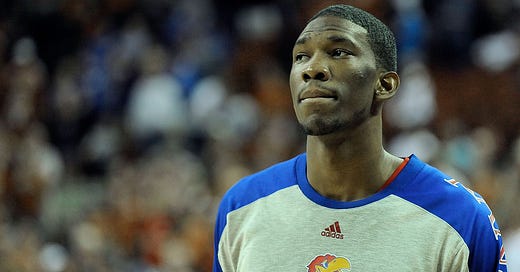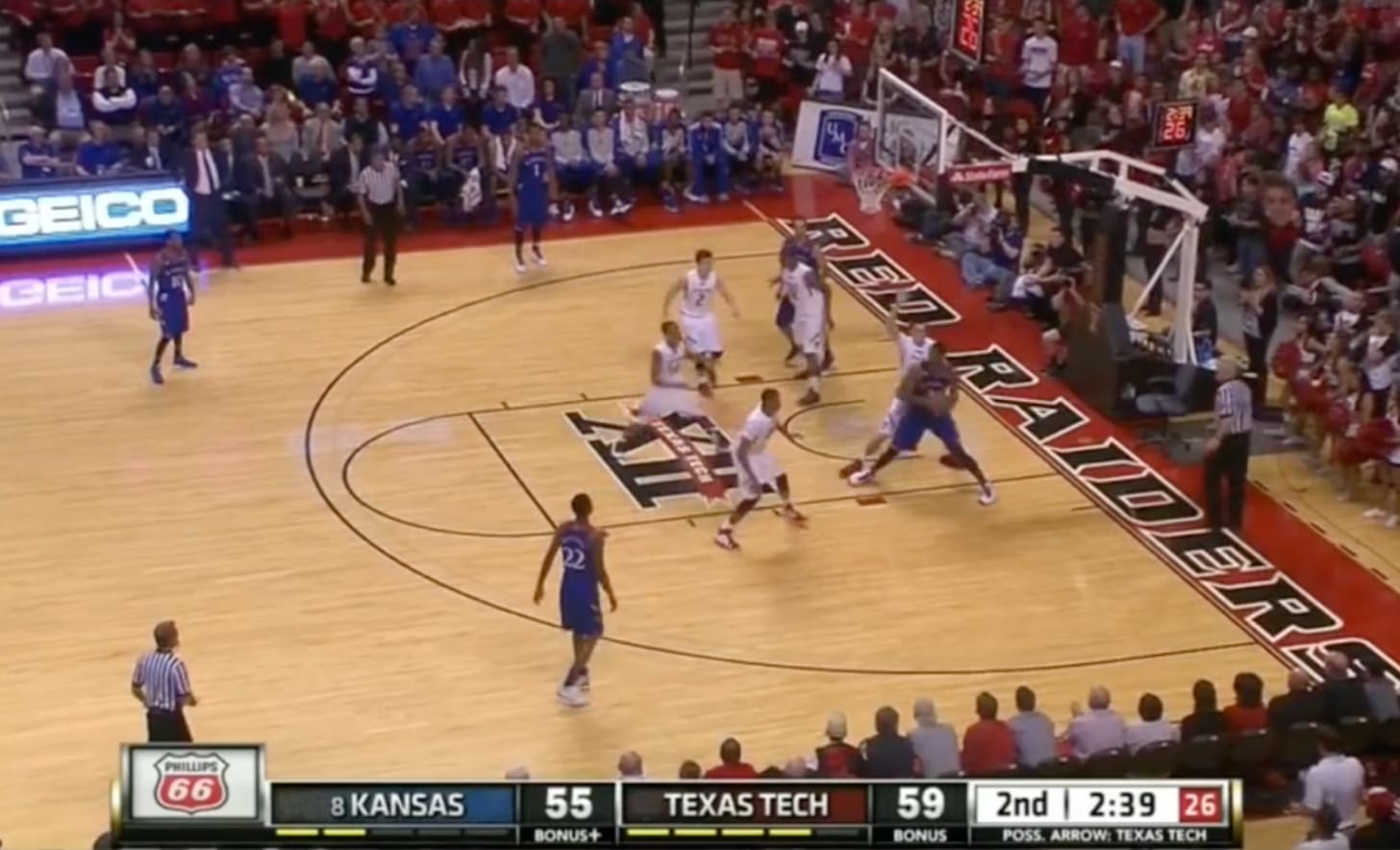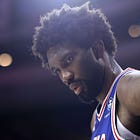Joel Embiid at Kansas Was Even Better Than You Remember
Every excuse to watch old Joel Embiid highlights is a good excuse.
Saying that Joel Embiid was a great player at Kansas is anything but a hot take.
Even though he fell to the Sixers at No. 3 in the draft, pretty much everyone agreed that he was the best prospect in the 2014 class by the season’s end. His broken foot is probably the biggest blessing in disguise the Sixers have ever gotten. If a healthy Embiid were an option a decade ago, either the Cavs or the Bucks sprint to the podium with a card that has his name on it.
But I don’t think most remember just how surreal Embiid was during his 28-game stint with the Jayhawks — perhaps in large part because his basic box score stats were simply good, not extraordinary. He only averaged 11 points and eight rebounds per game, and never scored more than 18 in a single outing. Sure, the efficiency was absurd (65.5 TS% as a 19 year-old should be impossible), but just looking at the numbers, Embiid looks like a good prospect, not an outlier-great one. That is, until you put on the tape, and see one of the most outrageously talented draft prospects ever.
Even though Embiid still posts up pretty often in 2024, he doesn’t do it with anywhere near the frequency did in his younger days. He’s gradually drifted outward with the game, shooting more threes and operating more in isolation from the elbow (for reference, Embiid only attempted five total threes in college). Embiid had a whopping 181 post-up possessions at Kansas that led to a result, and KU averaged 1.077 points on those post-ups, per Synergy. That was good for the 89th percentile back in 2014. His jumper wasn’t as pure, he wasn’t nearly as strong, and most importantly, he had not yet adopted the way of the grift. Yet, it was still a sight to behold whenever young Embiid caught the ball inside. In just his fourth ever season of professional basketball, he was already cranking out dream shakes and drop stepping overmatched Big 12 centers into oblivion.
If you’re wondering why Embiid didn’t get more scoring opportunities like this in college, it’s probably a question Kansas coach Bill Self asks himself every once in a while too. Embiid’s standalone brilliance lifted what was an otherwise disappointing Jayhawks team to a 2-seed in March Madness. Andrew Wiggins did just enough to not tank his status as the No. 1 ranked high school recruit, as evidenced by his still going No. 1 overall in the draft. But anyone who watched that team knew that Embiid impacted their success on a far more meaningful level. KU even slid to a 3-3 finish and a Round of 32 exit after Embiid was ruled out for the season with injury.
Probably the simplest way to illustrate their problems is with this — the 2014 Kansas Jayhawks often had 2020 Sixers-esque spacing.
Notice how 1) Perry Ellis is posting up at the same as Embiid on the opposite block, which happened a ton in this offense, and 2) though Embiid’s other three teammates are standing in decently spaced spots, not a single defender on the court cares a lick about them shooting an open three.
Unlike in 2021 where Embiid fixed some of the Sixers’ spacing issues by becoming an elite shooter himself, 2014 Embiid’s shooting touch came in sparse flashes. He shot a surprisingly meager 68.5% from the free throw line in college, and as noted before, almost never ventured out past the three-point line.
Still, you can see what was coming if you look close enough. He was already working on the patent for his righty jab into face-up jumper sequence, and he was often the beneficiary of kind bounces on turnaround shots due to his soft touch.
As you also might have noticed, even at a leaner build, Embiid is comically larger and stronger than everyone he went up against. So many of his buckets were basic seals into dunks and layups where Kansas threw him a Nico Batum-style pass over the top. There was no need for things to be too complex when the 7-foot-2 Cameroonian big inside can simply catch the lob pass then go up.
The funniest matchup of all, though, has to be the two games Embiid played against Iowa State, where he was guarded by none other than … Georges Niang!
Mind you, Niang was a very accomplished college player, and there are plenty of clips where his weird, overly physical chest bumping did result in him getting a stop on the future MVP. However, there were also very stark reminders of how different Embiid and Niang are as athletes on multiple occasions.
It’s easy to draw a line from what Embiid was doing on offense in 2014 to what he does now in 2024. The feel, rhythm and refinement are all improved, but it’s still a lot of the same stuff. If you showed someone in 2014 what Embiid’s scoring bag would look like in the NBA, they might be a little surprised, but they wouldn’t have thought it to be an impossible outcome.
The same can not be said for Embiid’s defense. It’s not that he got significantly better or worse relative to the competition he was playing against — it’s that Embiid plays a completely different style of defense now compared to what he did at Kansas.
Present-day Joel is one of the best defenders in the world, even if he’s perennially underrated on that end of the floor. There are few better at deep drop coverage in pick and roll, and in any crucial moment where a stop is desperately needed, Embiid isn’t afraid to come up to the level and switch onto anyone in the association. There’s a reason why for eight seasons straight, Sixers’ opponents essentially only attempt shots around the rim when Embiid is on the bench. He’s hyper aware of so many different actions, blowing up so many things by rotating to the rim, and consistently avoids needless foul trouble.
However, given both his history with both injuries and conditioning, Embiid’s effort level on defense in the 2020s does wane quite often. He knows he can’t go 100% all out each possession without taking a major risk. Not to mention, Embiid only played 23 minutes per game back at Kansas, a much lesser workload than 30-35 minutes he’s given the Sixers every night for the better part of eight years. Overall, his technique and discipline are amazing, even if the motor at ties is subpar.
Juxtapose that to a 19 year-old Embiid, whose technique was all over the place, and got in rampant foul trouble often, but moved around the floor like a gazelle sprinting away from a predator.
For example, Kansas often had Embiid hard hedge ball screens — i.e. the big steps above the screen to stop and bump the ball handler, preventing them from turning the corner. It’s a coverage that’s mostly gone by the wayside in the modern NBA, given how easily it can be picked apart by an elite passer and the immense strain it places on the big man defending the screener. It’s almost the complete opposite of the deep drop everyone’s become so accustomed to with No. 21.
Just watch young Embiid move on this play:
I mean this wholeheartedly — what in the actual world was that????
Humans that tall are not supposed to run that fast and jump with that much ferocity. It’s like watching a heat-seeking missile in action.
For as raw as Embiid was on defense in 2014, he still averaged a conference-best 2.6 blocks per game, and was every bit the enforcer fans expect him to be. He blocked shots with either hand. He blew up several 2-on-1 situations. He recovered at wild distances to track someone down from behind. He covered up for teammates’ mistakes with perfectly timed help defense. He was a sight to behold.
That’s not to say there weren’t lowlights. Embiid fouled out four times in 28 games and finished with four fouls in 11 others. Pick-and-pop bigs like Niang occasionally gave him issues – and even back then, despite Jo’s solid rebounding numbers, Kansas fans screamed at their TVs for someone to grab a rebound, much like Philly fans did this past postseason.
But there are few more entertaining things in basketball than a fully healthy, fully agile Embiid roaming around the court and hunting the basketball down. The big man obviously turned out pretty well anyway, and diversified his offensive game to the point that he beame one of the most prolific scorers in NBA history. But it’s fascinating to think about what he might’ve looked like if a) he never suffered all the foot injuries, and b) he eschewed the 30 pounds of muscle he put on and instead remained a lean, hard-hedging defensive machine. It’s a weird world where Embiid spends more time acting like peak Anthony Davis on defense, but without the offensive limitations that hold AD back from reaching the uppermost echelon that MVPs inhabit.
Overall, there’s not much to actually be learned from binging basketball film that’s a decade old. Even though he’s the recipient of constant hate and slander online, most people know deep down just how insanely talented Embiid is. Watching what he did at Kansas only confirms how special he’s always been.
But it’s a worthwhile thing to do if you’re a basketball die-hard and have the time. Embiid was not a product of brilliant prospect evaluation that couldn’t have been done by another team. He was not some mystery with concerns about how his game might translate. He was an unbelievably gifted big man who would have been the easy No. 1 draft if the bones inside his feet held up.
For as much stress and pain that Sixers’ fans have endured during The Process era, looking back at Embiid’s college tape serves an important reminder — this dude is incredibly fun to watch and to root for. When it’s all going right, he’s an absolute joy on the court, and that’s something worth remembering each and every day.
Daniel Olinger is a writer for the Rights To Ricky Sanchez, and author of “The Danny” column, even though he refuses to be called that in person. He can be followed on X @dan_olinger.
“The Danny” is brought to you by the Official Realtor Of The Process, Adam Ksebe.









